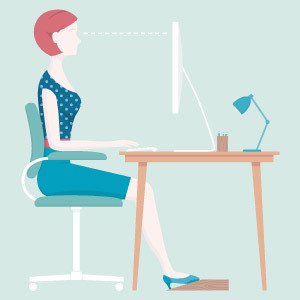How to position yourself in front of your screen?
We spend a lot of time sitting in front of our computers; it's worth taking a few minutes to find the ideal position! If you don't, you risk developing bad habits that can lead to back, neck and knee pain. Here are some recommendations for working comfortably. :)
1
Sit well back in your office chair and adjust the height so that your feet are flat on the floor. Your spine is perfectly straight and forms a right angle with your thighs. Your back is pressed against the seat. To avoid looking too cramped, your shoulders should be relaxed, even during stressful moments!
Your forearms should be placed horizontally, slightly open, parallel to the surface of the desk and at a 90° angle to your elbows. If your chair has armrests, adjust them so that they just touch the bottom of your elbows. Everything clear?
Your knees should be positioned at an angle of more than 90° to keep them supple and promote good blood circulation. Pssst ... avoid crossing your legs: your pelvis and knees hate this.
For more comfort, there are ergonomic accessories that can support your sitting position, such as footrests (to prevent swelling), backrests (to fit perfectly into the hollow of your lower back), split keyboards (to keep your wrists and forearms in a relaxed position) and vertical mice.
SIT DOWN CORRECTLY
It is very easy to find the right position, just follow the 90° rule:Sit well back in your office chair and adjust the height so that your feet are flat on the floor. Your spine is perfectly straight and forms a right angle with your thighs. Your back is pressed against the seat. To avoid looking too cramped, your shoulders should be relaxed, even during stressful moments!
Your forearms should be placed horizontally, slightly open, parallel to the surface of the desk and at a 90° angle to your elbows. If your chair has armrests, adjust them so that they just touch the bottom of your elbows. Everything clear?
Your knees should be positioned at an angle of more than 90° to keep them supple and promote good blood circulation. Pssst ... avoid crossing your legs: your pelvis and knees hate this.
For more comfort, there are ergonomic accessories that can support your sitting position, such as footrests (to prevent swelling), backrests (to fit perfectly into the hollow of your lower back), split keyboards (to keep your wrists and forearms in a relaxed position) and vertical mice.
2
Ideally, your eyes should be at an angle of between 20 and 22 degrees to your screen. If you do not have a compass in your eye, position yourself so that your eyes are slightly below the top of your screen.
You can also adjust the light intensity of your screen to prevent eye fatigue. Choose a light background, the contrasts will be less intense than with a dark background.
If you have two screens, sit in the middle and prefer a swivel office chair so that you can focus on either screen without twisting your neck.
ADJUST YOUR SCREEN
To determine the correct distance between you and your screen, look straight at it and stretch out an arm in front of you: this is the minimum distance you should keep. It is usually between 50 and 70 cm, depending on the size of your screen.Ideally, your eyes should be at an angle of between 20 and 22 degrees to your screen. If you do not have a compass in your eye, position yourself so that your eyes are slightly below the top of your screen.
You can also adjust the light intensity of your screen to prevent eye fatigue. Choose a light background, the contrasts will be less intense than with a dark background.
If you have two screens, sit in the middle and prefer a swivel office chair so that you can focus on either screen without twisting your neck.

3
Leave at least 10 cm between the space bar on your keyboard and the edge of the table, and try to type as often as possible without leaning on the table.
If possible, place your desk perpendicular to the windows so as not to be disturbed by daylight, and add an extra lamp for more comfort.
As a bonus, put within reach or sight things that can make you feel good during the day: a funny picture, a nice plant, a chocolate bar, mantras, personal trinkets... This is also part of the small adjustments that are essential to feel good at your workstation!
ADJUST YOUR WORK SURFACE
Ideally, it would be good to be able to adjust the height of your desk or work table. Depending on your height, it should be between 62 and 82 cm.Leave at least 10 cm between the space bar on your keyboard and the edge of the table, and try to type as often as possible without leaning on the table.
If possible, place your desk perpendicular to the windows so as not to be disturbed by daylight, and add an extra lamp for more comfort.
As a bonus, put within reach or sight things that can make you feel good during the day: a funny picture, a nice plant, a chocolate bar, mantras, personal trinkets... This is also part of the small adjustments that are essential to feel good at your workstation!
4
Please remember to come back :)
Change your posture from time to time during the day, for example by varying the angle of your backrest. There is no such thing as an ideal posture if you hold it for too long a time.
If possible, take a break of 5 to 10 minutes every hour if you work continuously behind a screen. Leave your place of work, move, stretch, run, catch your breath, call ... and again!
Are you still there? Is everything going well? Let's get cracking. :)
RELAX!
Take your eyes off the screen from time to time and look as far away as possible. This is a great way to take a visual break. If you are facing a wall, stand up and walk around outside or in the corridors looking far... far... far... away.Please remember to come back :)
Change your posture from time to time during the day, for example by varying the angle of your backrest. There is no such thing as an ideal posture if you hold it for too long a time.
If possible, take a break of 5 to 10 minutes every hour if you work continuously behind a screen. Leave your place of work, move, stretch, run, catch your breath, call ... and again!
Are you still there? Is everything going well? Let's get cracking. :)
